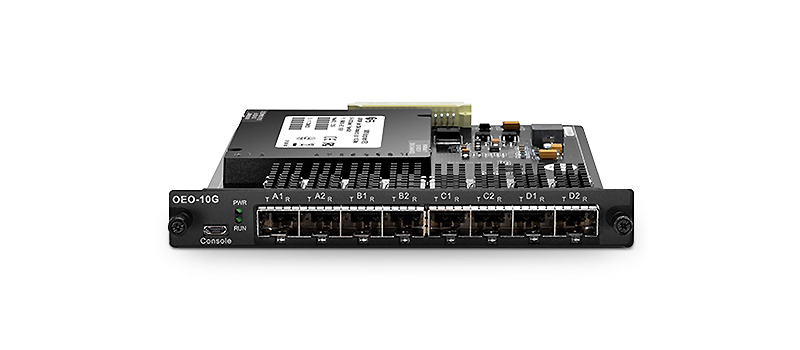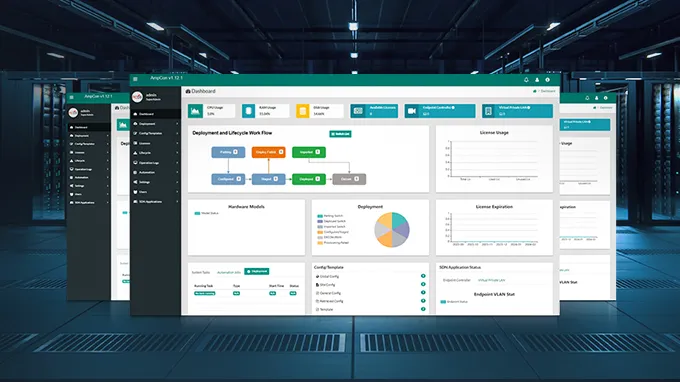The Versatile Optical Transponder (OEO) in WDM System
Optical transponder, also referred to as O-E-O (optical-electrical-optical) is an integrated part and is very crucial for the signal transmission in the whole WDM network system. An optical transponder works by converting the incoming signal from the end or client service to a WDM wavelength. This process is important in WDM systems and this post will explain why and how it is achieved by optical transponder.
What Is Optical Transponder (OEO)?
An optical transponder consists of a transmitter and a responder, which is similar to a transceiver that includes a transmitter and a receiver. The optical transponder extends the transmission distance by converting the wavelengths and amplifying the signal. It automatically receives, amplifies, and then retransmits a signal on a different wavelength without changing the data/signal content. That is to say, an optical signal received by the transponder is converted to an electrical data stream which it then processes and regenerates. The transponder then converts the signal of standard optical wavelengths to an optical CWDM (coarse WDM) or DWDM (dense WDM) signal. This process is commonly referred to as OEO (optical to electrical to optical) conversion.
Figure 1: Schematic diagram of a fiber optic transponder
Instead of simply regenerating the original signal during the process, modern WDM transponders are endowed with the 3R system (reshape, retime, reamplify), capable of cleaning up, monitoring, and amplifying the signal accurately and closely.
Why Need Optical Transponder (OEO) in WDM System?
The optical transponder is needed in the WDM system for several reasons. Firstly, in a case where equipment of different wavelengths need to communicate with each other, the optical transponder can solve the incompatible problem between them. Secondly, there is more than one fiber optic network provided by different providers and of different standards. We need a WDM transponder to traverse from one fiber optic network to another. These requirements are divided into three converting types in practical applications.
Convert Multimode to Single-mode Fiber
We know that multimode fiber (MMF) is often used in short-distance transmission and single-mode fiber (SMF) is for long-distance transmission. Mode conversion is needed when the transmission distance exceeds the limitation of MMF or when connectivity between a multimode device and a single-mode device is required. For instance, the following two switches located far from each other are connected via two optical transponders that convert MMF to SMF. The typical application of this function is for extending the distances of 10G Optical Transport Network (OTN) and Synchronous Optical Network (SONET) ring.

Figure 2: Convert multimode to single-mode fiber
Convert Dual Fiber to Single Fiber
Conversion between dual fiber and single fiber is also required in networks. Dual fiber uses the same wavelength over two different strands of fiber, while single fiber uses two different wavelengths over one strand of fiber, which is known as bidirectional (BiDi) transmission. In this case, two dual fiber switches of long distances are linked via two optical transponders. As the BiDi single fiber owns two different wavelengths in one strand of fiber, the transmit (Tx) at one end of the fiber matches the receive (Rx) from the other end, and vice versa.

Figure 3: Convert dual fiber to single fiber
Convert Wavelengths
Wavelength conversion is the most common application of optical transponders in WDM systems. Fiber network equipment with fixed fiber interfaces that operate over legacy wavelengths (850 nm, 1310 nm, 1550 nm) must be converted to CWDM or DWDM wavelengths via optical transponders, which are capable of wavelength conversion together with small-form pluggable (SFP) transceivers that transmit different wavelengths. In the figure below, a 10G switch with signal output at 1310 nm is needed to be connected to a CWDM Mux/Demux channel port with a wavelength of 1530 nm. A transponder operating with SMF SFP+ and a 1530nm CWDM SFP+ is used between the switch and the CWDM Mux/Demux to achieve wavelength conversion.

Figure 4: Convert wavelengths
Transponder vs. Transceiver and Muxponder
In fiber optic networks, transponder, transceiver, and muxponder are all devices that function for receiving and transmitting optical signals. Although they have similarities in their functionality, they are essentially different devices considering their designed purposes. Fiber optic transceivers are limited to electrical-optical function only and are a serial electrical interface, whereas transponders convert an optical signal at one wavelength to another and use parallel electrical interface. As such, WDM transponders can be considered as two transceivers placed back-to-back. Fiber optic muxponders send and receive optical signals on a fiber in much the same way as transponders but the former has the additional function of multiplexing multiple sub-rate client interfaces onto the line interface of higher rate.
For example, a 4 channels multirate WDM transponder with 8 SFP/SFP+ ports can convert a multimode 1Gbps or 10Gbps signal to a single-mode signal of CWDM/DWDM wavelength, so that the 1G/10G link can be extended to a longer length. Although the signal is amplified, the data rate before and after the conversion will not be changed.

Figure 5: 4 channels multirate WDM transponder (line card type) with 8 SFP/SFP+ ports
As for WDM fiber optic transceivers, CWDM/DWDM transceiver modules are designed to transmit and receive an optical signal of a specific wavelength. It will not amplify the optical signal or change its mode, wavelength, or speed.

Figure 6: CWDM transceivers
In terms of fiber optic muxponders, they are multiprotocol multirate devices that integrate several different services into one fiber. For example, a 200G muxponder provides a high transport capacity of 200G over a single wavelength, it can aggregate 10GbE, 40GbE, and 100GbE, STM-64/OC-192, OTU2/OTU2e/OTU3/OTU4 OTN multi-protocol services into a single 200G /OTU2C standard OTN trunk.
Figure 7: 200G multiprotocol multi-rate muxponder aggregates different sub-rate services
Standalone or Line Card WDM Transponder, Which to Choose?
When looking for a WDM transponder (OEO) in the market, there are both standalone and line card types of transponders available. Each of them has their advantages and disadvantages in usage.
For standalone WDM transponders, there are rackmount types and desktop types. Rack mount types have ears allowing for easy installation on standard racks, while desktop types are usually not in standard 1U size and can only be put on shelves or desks. Both of the rack mount type and desktop type are packed in an individual metal box, which protects the modules inside and enables the transponder to be used alone. However, standalone also means that it requires individual monitoring as well and takes up more space. Standalone WDM transponders usually with smaller capacity and fewer slots compared with same-size line card types. And the price for standalone transponders is higher due to its design.

Figure 8: Image for a standalone OEO
OEO line cards are plug-in types that are used with empty rackmount chassis. They have the advantages of smaller size, more interfaces taking up only a few spaces, and higher capacity in the same dimension. The OEO cards are managed together with other functional line cards, which means they can be flexibly removed, installed and monitored as a group. The line card types are often cheaper. The only shortcoming is that the line cards cannot be used alone and should be used in the chassis that hold them up.

Figure 9: OEO line card is used in rack mount chassis
Summary
Optical transponder is versatile for converting different types of signal, including multimode to single-mode, dual fiber to single fiber, and one wavelength to another wavelength. During the process, the signal is also re-amplified, monitored, and cleaned up but will not be modified to be different from its original bit rate. So that the transmission distance will be extended.
You might be interested in
Email Address

-
PoE vs PoE+ vs PoE++ Switch: How to Choose?
May 30, 2024














